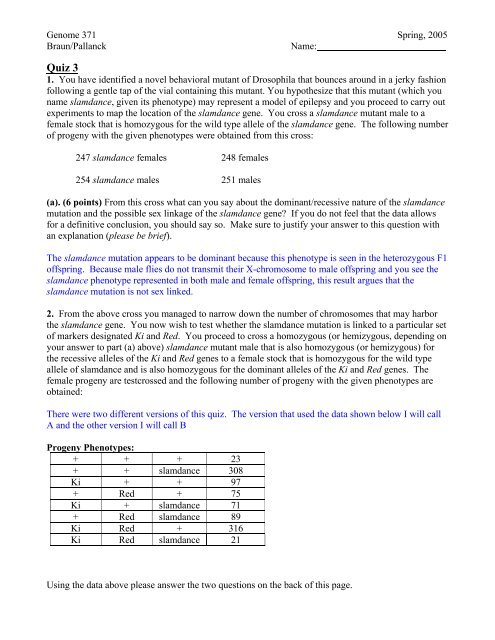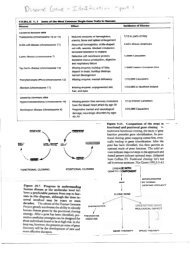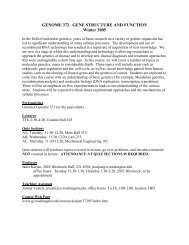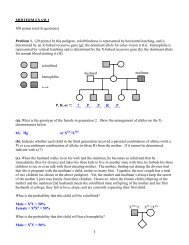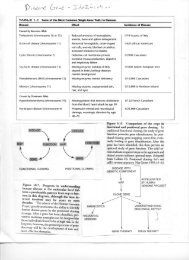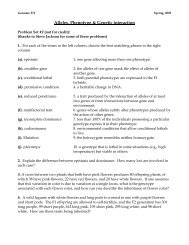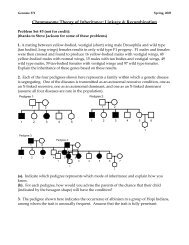Quiz 3
Quiz 3
Quiz 3
Create successful ePaper yourself
Turn your PDF publications into a flip-book with our unique Google optimized e-Paper software.
Genome 371 Spring, 2005<br />
Braun/Pallanck Name: .<br />
<strong>Quiz</strong> 3<br />
1. You have identified a novel behavioral mutant of Drosophila that bounces around in a jerky fashion<br />
following a gentle tap of the vial containing this mutant. You hypothesize that this mutant (which you<br />
name slamdance, given its phenotype) may represent a model of epilepsy and you proceed to carry out<br />
experiments to map the location of the slamdance gene. You cross a slamdance mutant male to a<br />
female stock that is homozygous for the wild type allele of the slamdance gene. The following number<br />
of progeny with the given phenotypes were obtained from this cross:<br />
247 slamdance females 248 females<br />
254 slamdance males 251 males<br />
(a). (6 points) From this cross what can you say about the dominant/recessive nature of the slamdance<br />
mutation and the possible sex linkage of the slamdance gene? If you do not feel that the data allows<br />
for a definitive conclusion, you should say so. Make sure to justify your answer to this question with<br />
an explanation (please be brief).<br />
The slamdance mutation appears to be dominant because this phenotype is seen in the heterozygous F1<br />
offspring. Because male flies do not transmit their X-chromosome to male offspring and you see the<br />
slamdance phenotype represented in both male and female offspring, this result argues that the<br />
slamdance mutation is not sex linked.<br />
2. From the above cross you managed to narrow down the number of chromosomes that may harbor<br />
the slamdance gene. You now wish to test whether the slamdance mutation is linked to a particular set<br />
of markers designated Ki and Red. You proceed to cross a homozygous (or hemizygous, depending on<br />
your answer to part (a) above) slamdance mutant male that is also homozygous (or hemizygous) for<br />
the recessive alleles of the Ki and Red genes to a female stock that is homozygous for the wild type<br />
allele of slamdance and is also homozygous for the dominant alleles of the Ki and Red genes. The<br />
female progeny are testcrossed and the following number of progeny with the given phenotypes are<br />
obtained:<br />
There were two different versions of this quiz. The version that used the data shown below I will call<br />
A and the other version I will call B<br />
Progeny Phenotypes:<br />
+ + + 23<br />
+ + slamdance 308<br />
Ki + + 97<br />
+ Red + 75<br />
Ki + slamdance 71<br />
+ Red slamdance 89<br />
Ki Red + 316<br />
Ki Red slamdance 21<br />
Using the data above please answer the two questions on the back of this page.
Genome 371 Spring, 2005<br />
Braun/Pallanck Name: .<br />
(a). (10 points) Does the slamdance gene appear to be linked to Ki or Red? If so, draw a genetic map<br />
that shows the arrangement of the Ki and Red genes with respect to the slamdance gene and the map<br />
distance separating the three genes, if possible. Please show your work for full credit.<br />
Answer for version A:<br />
Red<br />
23<br />
Slamdance<br />
19<br />
Ki<br />
Answer for version A:<br />
Red<br />
Slamdance<br />
14<br />
22<br />
Ki<br />
(b). (4 points) Given your answer to (a), would you expect that another marker that is linked to<br />
slamdance, but that maps 40cM away from the slamdance gene would exhibit evidence of linkage to<br />
the Ki or Red markers used in part (a) above? Why or why not?<br />
A marker that maps 40 cM away from slamdance would show linkage to one of the two markers that is<br />
linked to slamdance, but would be more than 50cM away from the other marker that is linked to<br />
slamdance. The maximum amount of recombination that can be observed is 50cM, so markers that are<br />
more than 50cM away from one another would not exhibit evidence of linkage.


